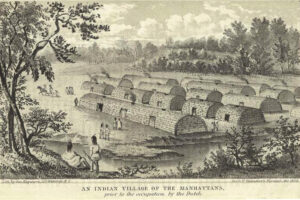National Native American Heritage Month is celebrated each year in November. It is a time to celebrate the traditions, languages, stories, and survival of Native American, Alaska Native, and Native Hawaiian communities.
What is now New York is the ancestral home of the Lenape Nation. The Lenape thrived here for thousands of years before the arrival of Europeans. Their homeland Lenapehoking spanned from Western Connecticut to Eastern Pennsylvania, and the Hudson Valley to Delaware, with Manhattan at its center.

The arrival of Europeans in North America was devastating to the Lenape. In 1626, the Lenape “sold” the island of Manahatta to the Dutch. The Dutch were of course deceptive in their dealings, as the concept of shared land use was fundamental to Lenape, and they did not believe that land could be privately owned. After the loss of their land led to a scarcity of essential resources, the Lenape could not farm and were forced to over-hunt.
Between 1600 and 1700, the Lenape were decimated by diseases and war. By 1700 their numbers were reduced to 3,000 at most. Before the European invasion, Lenape numbered at least 20,000. Smallpox, malaria, measles, and other diseases brought by the colonizers took a terrible toll. By 1750, the Lenape had lost an estimated 90% of their people.
The Treaty of Easton, signed in 1758 with the English, forced the Lenape to move westward into Pennsylvania and Ohio. More deceptive land treaties and forced migrations followed, and the Lenape were pushed further and further west, losing their connections to their traditional homeland. After the Indian Removal Act of 1830, passed by Congress during the Jackson administration, Lenape remaining in the eastern United States were forced to migrate to Indian Territory (present-day Oklahoma).
Today, many modern Lenape reside in Oklahoma and Kansas, where their ancestors settled after forced removal and relocation. Still others reside in their ancestral homelands. Their struggle for the preservation of their culture and heritage continues.
Other Resources:
Lenapehoking is the first Lenape-curated exhibition of Lenape historic and contemporary cultural arts in New York City.
Native Cinema Showcase is a week-long celebration of the best in Indigenous film. This year’s online program includes a total of 35 films representing 30 Native nations in eight different countries. And it’s free!
The Lenape Center “has the mission of continuing Lenapehoking, the Lenape homeland through community, culture, and the arts. Since 2009, the Lenape Center based in Manhattan and led by Lenape elders has created programs, exhibitions, workshops, performances, symposia, land acknowledgment, and ceremonies to continue our Lenape presence. We push back against our erasure and seed the ground with Lenape consciousness for the next generations.”



